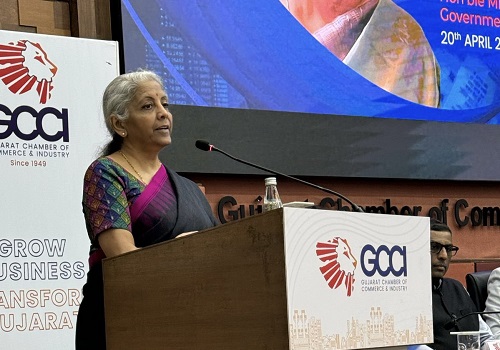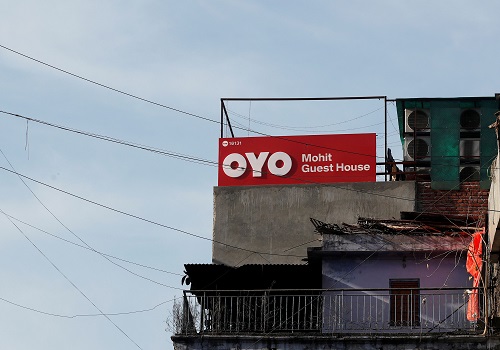Agri Commodity Technical Report 24 November 2022 - Geojit Financial Services

Follow us Now on Telegram ! Get daily 10 - 12 important updates on Business, Finance and Investment. Join our Telegram Channel
https://t.me/InvestmentGuruIndiacom
Download Telegram App before Joining the Channel
SPICES
• Mixed moves were witnessed in NCDEX spices complex on Wednesday. Turmeric and coriander futures pared initial losses and ended the day in green, while jeera futures was under pressure. Turmeric gained on fall in arrivals in the spot market. However, tepid demand weighed on, keeping gains under check. In the meantime, bargain buying was seen in dhaniya futures after the recent fall.
• According to the Spices Board, India exported 572890.71 tons of spices during Apr-Aug 2022, down by 14 per cent, compared to 666540.53 tons exported during the same time period a year ago. Export of jeera stood at 91505.49 tons, down by 26 per cent, while that of coriander is seen at 18557.72 , down by 12 per cent. In the meantime, both turmeric and small cardamom exports rose by 15 respectively and pepper exports increased seven per cent. Small cardamom export stood at 3794.69 tons, while that of turmeric and pepper was 74393.62 and 9587.86 tons respectively.
• The value of India's spices market is expected to rise to 1 trln rupees by 2025 from 800 bln rupees this year, with the share of the organised sector likely to reach 50% from 38%, according to experts at the National Spice Conference. Currently, the value of the organised segment is pegged at 300 bln rupees. Improved quality, introduction of smaller stock-keeping units and increased shelf life of spices is one of the major reasons for growth of the organised segment, Ramkumar Menon, chairman of World Spice Organisation, said at the conference. Growth prospects in the case of spices are high and branding plays an important role, as it not only makes a memorable impression on consumers, but allows customers and clients to know what to expect from a company. It is a way to distinguish oneself from competitors and clarify what makes one a better choice, according to a panel of experts at the conference. Currently, the branded spices market is growing at a compounded annual rate of 10-15%, against 7-10% in the case of the unorganised segment. India, the world's largest producer, exporter, and consumer of spices, produces 75 of its 109 varieties. Around 85% of the spices produced in India are consumed domestically. The country accounts for more than 48% of global demand.
• Production of spices in India is likely to have declined 1.5% on year to 10.9 mln tn in 2021-22 (Jul-Jun), according to data from Spices Board India. The country had produced 11.0 mln tn of spices in the previous year. Among the complex, a major rise in production was pegged in turmeric. The board has pegged turmeric production at 1.33 mln tn, up 18.4% on year. Jeera production was seen at 725,651 tn, down 8.8% on year due to lower acreage in Rajasthan and Gujarat, the key producer. Production of chilli, counted as one of the largest exported and produced spices in the country, is projected at 1.9 mln tn, compared with 2.0 mln tn a year ago. Production of pepper is seen at 60,000 tn, down 7.7% on year, while the output of small cardamom is seen rising by 3.6% on year to 23,340 tn, data showed.

COTTON
• The Cotton Association of India has retained its production estimate for the 2022-23 (Oct-Sep) season at 34.4 mln bales (1 bale = 170 kg), it said in a press release. Production of cotton in north zone, which includes Punjab, Haryana and Rajastan, is estimated at 4.7 mln bales by the association. The estimate for the central zone, which includes Gujarat, Maharashtra and Madhya Pradesh, is 19.8 mln bales. The estimate for the south zone is 9.2 mln bales. Other small states account for rest of the output. Total supply of cotton for the 2022-23 season is estimated at 38.8 mln bales. The association estimates imports at 1.2 mln bales, 200,000 bales lower from the previous year. Exports are seen at 3.0 mln bales, lower by 1.3 mln bales from the previous year. Arrivals of cotton as on Oct 31 were estimated at 1.8 mln bales by the association. The association sees closing stock of cotton as on Sep 30, 2023 at 5.8 mln bales.
• The US Department of Agriculture has lowered its estimate for global cotton output for 2022-23 (Oct-Nov) to 116.4 mln bales (1 US bale = 218 kg) from 118.1 mln bales projected a month ago. The reason for the lowered estimate is attributed to the damaged crop from Pakistan due to floods, the department said in its World Agricultural Supply and Demand Estimates report for November. The report said that global cotton production for November is estimated to be down 1.6 mln bales from October. Further, global cotton consumption is seen at 115 mln bales in November as against 115.6 mln bales a month ago. The consumption is seen lower due to a decline in mill use in Pakistan and Bangladesh, the report said. For November, global cotton exports are estimated at 43.2 mln bales, marginally down from 43.6 mln bales the previous month. The decline is due to lesser projected exports from West Africa along with import reductions from Bangladesh and China, hampering trade worldwide. The agency has also lowered its 2022-23 global ending stocks estimate to 87.2 mln bales from 88 mln bales last month. For India, the agency has maintained its November production estimate of 27.5 mln bales. The consumption estimate for the country is seen at 24.0 mln bales, steady from last month. For 2022-23, cotton ending stocks in India are now seen at 10.3 mln bales, higher than the 10.2 mln bales projected a month ago, the report said.
• Cotton ending stocks in India for 2022-23 are now seen at 10.2 mln bales, higher than 8.9 mln bales projected a month ago, the report said.The farm ministry today pegged the country's kharif foodgrain output in 2022-23 (Jul-Jun) at 149.9 mln tn, according to the first advance estimates released today. Cotton output in 2022-23 is pegged at 34.2 mln bales, as against 36.2 mln bales in 2021-22. But in its fourth advance estimate for 2021-22, the government had lowered its cotton output view to around 31.2 mln bales.
• The area under cotton across India in 2022-23 (Jul-Jun) season was over 12.7 mln ha as of Thursday, up 7.5% from a year ago, data from the farm ministry showed. Sowing has been completed in northern states and acreage in Haryana, the top producer in the region, fell 5.4% on year to 650,473 ha. In Punjab, it fell 2.4% to 248,000 ha. Inadequate power supply for irrigationand non-availability of canal water during the initial sowing stage led to a drop in acreage in the northern states, experts said. In Gujarat, acreage rose to 2.5 mln ha as against 2.2 mln ha a year ago. In Maharashtra, the area under the crop increased 7.3% on year to 4.2 mln ha, while in Telangana, it fell 2.2% to 2.01 mln ha. Gujarat is the top producer of cotton in India, followed by Maharashtra and Telangana. Together, Gujarat and Maharashtra account for 50-55% of the country's total production.
• According to a circular from MCX, the exchange is in process of modifying the Cotton contract specification. Accordingly, with effect from August 29, 2022, no fresh positions will be permitted in Cotton January 2023 expiry contract which has currently nil open interest. Cotton February 2023 expiry and subsequent expiry contracts will temporarily not be launched for trading till such time the revised contract specification is finalized. No changes for other running Cotton contracts with Open Interest.

OTHERS
• Farmers in the country have sown rabi chana across 5.26 mln ha as of Thursday, down 0.5% on year, data from the farm ministry showed. The marginal decline in chana acreage is primarily due to lower sowing in Madhya Pradesh, the top grower. However, acreage increased in other key growing states of Maharashtra, Rajasthan, Gujarat and Karnataka. In Maharashtra, the second-largest grower, chana acreage was up 1.4% on year at 513,000 ha, while area in Rajasthan was 10% higher at over 1.8 mln ha. Farmers in Karnataka have sown chana across 832,000 ha so far in the rabi season, up 2.1% from a year ago. Farmers in Gujarat have sown the rabi pulse across 180,000 ha, up 990% from previous year. Acreage of chana, however, declined 21.7% on year to 1.2 mln ha in Madhya Pradesh, the top grower, as farmers shifted to more remunerative crops such as wheat.
• The farm agency of Canada, one of the biggest exporters of pulses to India, has scaled up its estimate for chana prices in 2022 -23 (Aug-Jul) due to lower carryover stocks. The agency, Agriculture and Agri-Food Canada, now sees chana prices in 2022-23 at $925 per tn compared to its previous estimate of $900 per tn. "The price forecasts are subject to significant volatility due to the elevated amount of uncertainty in global markets," the agency said in its October report. Meanwhile, the agency cut its estimate for the average price of dry beans to $1,235 per tn from $1,250 per tn in September due to expectations of higher supply globally. The production estimates for chana, masur, dry peas and dry beans were left unchanged from last month. Production of chana in 2022-23 is expected to rise sharply to 157,000 tn from 76,000 tn in 2021-22, while the output of dry beans is seen at 305,000 tn, according to the report. Agriculture and Agri-Food Canada is responsible for policies governing the production, processing, and marketing of all farm, food, and agri-based products.
• The Union Cabinet approved 2-9% hike in the minimum support price of six rabi crops for the coming marketing season starting April.The minimum support price of wheat has been increased by 5.5% to 2,125 rupees per 100 kg, while that of chana was raised by 2.0% to 5,335 rupees per 100 kg, the government said. Wheat, the crucial rabi crop, accounts for over 70% of the rabi foodgrain output, and chana is the largest rabi pulse crop. Minimum support prices, or the rates at which the government buys crops from farmers in case prices slip in the market, gives security and direction to growers in terms of realisation from their produce. They also help boost production of a desired crop. The Cabinet also approved increasing minimum support price of mustard by 7.9% to 5,450 rupees per 100 kg, and for masur by 9.1% to 6,000 rupees per 100 kg. The support price for barley was increased by 6.1% to 1,735 rupees per 100 kg. In the fourth advance estimate, the government predicted output of wheat in the 2021-22 (Jul-Jun) crop year at 106.8 mln tn, while oilseed production is pegged at 37.69 mln tn. Pulses output was seen at 27.69 mln tn, against 27.75 mln tn estimated in the third advance estimate.
• The government has pegged the output of pulses at 8.4 mln tn, significantly lower than 9.5 mln tn estimated in the first advance estimate of last year. As of Thursday, the area under pulses fell 4.1% to 13.2 mln ha across the country. The drop in acreage of pulses is a cause for concern as it could lead to higher prices in retail markets during the pulses marketing season. Farmers have shifted to oilseeds and cotton this kharif season due to higher price realisations of the crops and delay in monsoon rainfall in June and July.

OIL AND OILSEEDS
• Farmers have sown mustard across 6.3 mln ha in the country, up 15% year-on-year, in the ongoing 2022-23 (Oct-Nov) rabi season as of Thursday, according to the farm ministry's data. Mustard is one of the two main crops that are grown in India during the rabi season. The normal area of the crop for the entire rabi season is around 6.4 mln ha, and so far, farmers have sown in over 6.3 mln ha. Farmers said most of the sowing is complete, which is a good sign for a bigger crop harvest during the Feb-Mar harvesting period. Acreage in Rajasthan, the largest producer of the oilseed, rose 17% to around 3.6 mln ha from 3 mln ha in the same period last year. "Attractive prices have resulted in higher sowing of mustard this year," said Anil Chattar, joint-secretary at the Mustard Oil Producers Association, adding that the hike in minimum support prices of mustard have also incentivised farmers to sow more. On Oct 18, the government had hiked the MSP for the crop by 400 rupees to 5,450 rupees per 100 kg.
• India's vegetable oil imports surged 32% year-on-year to 1.4 mln tn in October, the Solvent Extractors' Association of India said. For 2021-22 (Nov-Oct), imports of vegetable oil were at 14.4 mln tn, against 13.5 mln tn in the year-ago period. The vegetable oil basket consists of edible and non-edible oils. Edible oil imports for Nov-Oct stood at 14.0 mln tn, against 13.1 mln tn in the year-ago period, the data showed. The edible oil import basket comprises crude and refined palm oils, crude soyoil, sunflower oil, and mustard oil. India imports palm oil from Indonesia and Malaysia, and soyoil from Argentina. Sunflower oil is imported from Ukraine and Russia, and canola oil from Canada. India is the world's largest importer of edible oils. As of Nov 1, about 647,000 tn of edible oil was at ports, against 565,000 tn a year ago, while 1.85 mln tn was in the pipeline, against 1.15 mln tn during the same period last year, the SEA said.
• Crude palm oil output in Malaysia rose 2.4% on month to 1.8 mln tn in October, data from the Malaysian Palm Oil Board showed. Export of palm oil in October grew 5.7% on month to 1.5 mln tn, while outbound shipments of biodiesel fell 35.6% on month to 18,894 tn, the data showed. Palm oil is also used to make biofuel. Total stocks of palm oil in the country were up 3.7% on month at 2.4 mln tn as of Oct 31. Malaysia is the world's second-largest producer of crude palm oil, and India is the largest consumer of edible oils in the world.
• With the focus to promote development and use of sustainable palm oil production and trade, Solvent Extractors' Association of India and Solidaridad Asia renewed a memorandum of understanding with the Indonesian Palm Oil Board today, according to a statement by SEA. The memorandum was signed in the Indonesia-India joint working group meeting, which took place in Bali, Indonesia. With the memorandum of understanding, all three organisations agreed to facilitate the implementation of Indonesian Sustainable Palm Oil through activities, which advance the interests of producers, processors, users, and consumers through product and market development. "The parties agreed to cooperate on resolution of policy matters through a joint effort, where the interests of the three organisations are amenable," according to the release.
• The Solvent Extractors’ Association of India aims to grow genetically modified mustard across 200 farms in the ongoing rabi season and has sought seeds from the farm ministry for the purpose. In a letter to the ministry, the industry body has sought 100 kg of genetically modified mustard seeds to cultivate the crop across 200 model farms during the ongoing rabi season. Under its Mustard Model Farms Program, the solvent extractors’ body targets to have 1,000 mustard farms in the major growing states of Rajasthan, Madhya Pradesh, Punjab, and Uttar Pradesh. In a bid to boost production of edible oils, the environment ministry’s Genetic Engineering Appraisal Committee had on Oct 25 recommended environmental release of genetically modified mustard. The decision paved the way for commercial cultivation of India’s first transgenic food crop. In its letter, the solvent extractors’ body expressed hope that GM mustard cultivation "will lead to a yellow revolution to achieve 'atmanirbharta' (self-reliance) in edible oils" for India, a top importer of edible oils.
• The government has exempted wholesalers and big retail companies from stockholding limits on oil and oilseeds with immediate effect, the government said in a release on Tuesday. "As there is considerable decline in the prices of edible oil in the international market as well as the domestic market, the stock limit order was reviewed by the department," the release said. Due to the imposition of stock limits on oil and oilseeds, wholesalers and big chain retail outlets were facing hurdles in sales amid limited quantities, the release said. In October last year, the government had imposed stock limit on edible oil and oilseeds to address the volatility in domestic and global prices and keep a check on hoarding, especially of soybean seeds. It later extended the order till Dec 31. Doing away with the stock limits on wholesalers and big retail companies would allow them to keep various varieties and brands of edible oils. It would also boost the procurement of oilseeds, while ensuring remunerative returns to domestic farmers, the release said.
• India's soymeal exports in September rose 287.5% on year to 31,000 tn, the Soybean Processors Association of India said. For 2021-22 (OctSep), soymeal exports plunged to 650,000 tn from 1.9 mln tn in the previous year. Soymeal is primarily used as poultry and livestock feed. Indian soymeal is non-genetically modified and considered rich in protein.
• India's exports of oilmeals rose 31% on year to 240,669 tn in September, according to data released by the Solvent Extractors' Association of India today. During the first six months of the financial year that began on Apr 1, exports of oilmeals rose 39% on year to 1.8 mln tn. The rise in exports of oilmeals was mainly attributed to the surge in exports of mustard meal that spiked to 1.2 mln tn in Apr-Sep from 605,355 tn in the year-ago period. However, in case of soymeal, exports remained subdued as "India is out priced in the international market", the association said in a release. Exports of soymeal plunged to 121,976 tn in Apr-Sep compared with 161,588 tn a year ago.
• The US Department of Agriculture has scaled down its estimate for global production of oilseeds in 2022-23 (May-Apr) to 645.6 mln tn from 646.6 mln tn. "Lower soybean, sunflowerseed, and cottonseed production is partly offset by higher rapeseed," the agency said in its November report. The agency has projected global soybean output in 2022-23 at 390.5 mln tn, 500,000 tn lower than the estimate in October. The lower estimate is mainly due to a decline in production from Argentina, according to the report. Soybean production in Brazil is estimated at 152 mln tn, steady from last month's projection, while that in Argentina is projected at 49.5 mln tn, against 51.0 mln tn estimated last month. The agency has scaled up its estimate for soybean production in the US, and now sees output at 118.27 mln tn, against its projection of 117.38 mln tn last month. Brazil is the world's top producer of soybean, followed by the US and Argentina. The agency has also scaled up its estimate for global ending stocks of soybean to 102.2 mln tn from 100.5 mln tn in October, with most of the rise in Brazil and China. The estimate for global soyoil production in 2022-23 has also been kept largely unchanged at 61.9 mln tn. However, the estimate for global soyoil exports in 2022-23 has been revised marginally lower to 12.70 mln tn from 12.90 mln tn estimated the previous month. Additionally, the department has projected global soymeal output in 2022-23 at 258.5 mln tn, up from 256.6 mln tn in October. The agency estimates global exports of soymeal at 69.95 mln tn, compared with 69.93 mln tn pegged last month.
To Read Complete Report & Disclaimer Click Here
For More Geojit Financial Services Ltd Disclaimer https://www.geojit.com/disclaimer
SEBI Registration Number: INH200000345
Views express by all participants are for information & academic purpose only. Kindly read disclaimer before referring below views. Click Here For Disclaimer























